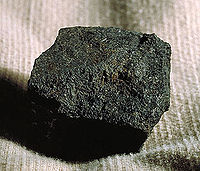
Photo from wikipedia
Abstract The crushing energy of coal plays an important role in mining, gas extraction, occurrence of outburst accidents, and coal pulverisation engineering. To calculate the crushing energy of coal, a… Click to show full abstract
Abstract The crushing energy of coal plays an important role in mining, gas extraction, occurrence of outburst accidents, and coal pulverisation engineering. To calculate the crushing energy of coal, a fractal model considering the crack area was established. The fractal fragmentation distribution and the fractal crack distribution, with their fractal dimensions (Df and Ds) calculated from the particle size distribution, were used to calculate the new specific surface area (SSA) of coal after crushing. Two different experimental methods, quasi-static compression on a single particle (strain rate: 0.0005–0.001 s−1) and dynamic impact on particles (strain rate: 300 s−1), were used to crush coal particles to particle size of 2–3 mm. The experimental results show that Df for coal particles under quasi-static compression (QSC) and dynamic impact (DI) are 1.44–1.85 and 1.9–2.74, respectively. Df increases significantly with the crushing ratio, and there is a limit value, which is defined as Ds. Ds measured by QSC and DI were 1.87 and 2.75, respectively. The SSA of a single particle obtained by the proposed fractal model increases with the decrease in the particle size, which can be highly consistent with the BET SSA by fitting. The surface energy of coal particles under QSC and DI calculated by the traditional theory, which does not take into account the crack area, is 240.10 J/m2 and 180.92 J/m2, respectively, independent of the crushing ratio. The surface energy calculated by the fractal model is 3.55 J/m2, taking into account the frictional heat.
Journal Title: Fuel
Year Published: 2020
Link to full text (if available)
Share on Social Media: Sign Up to like & get
recommendations!